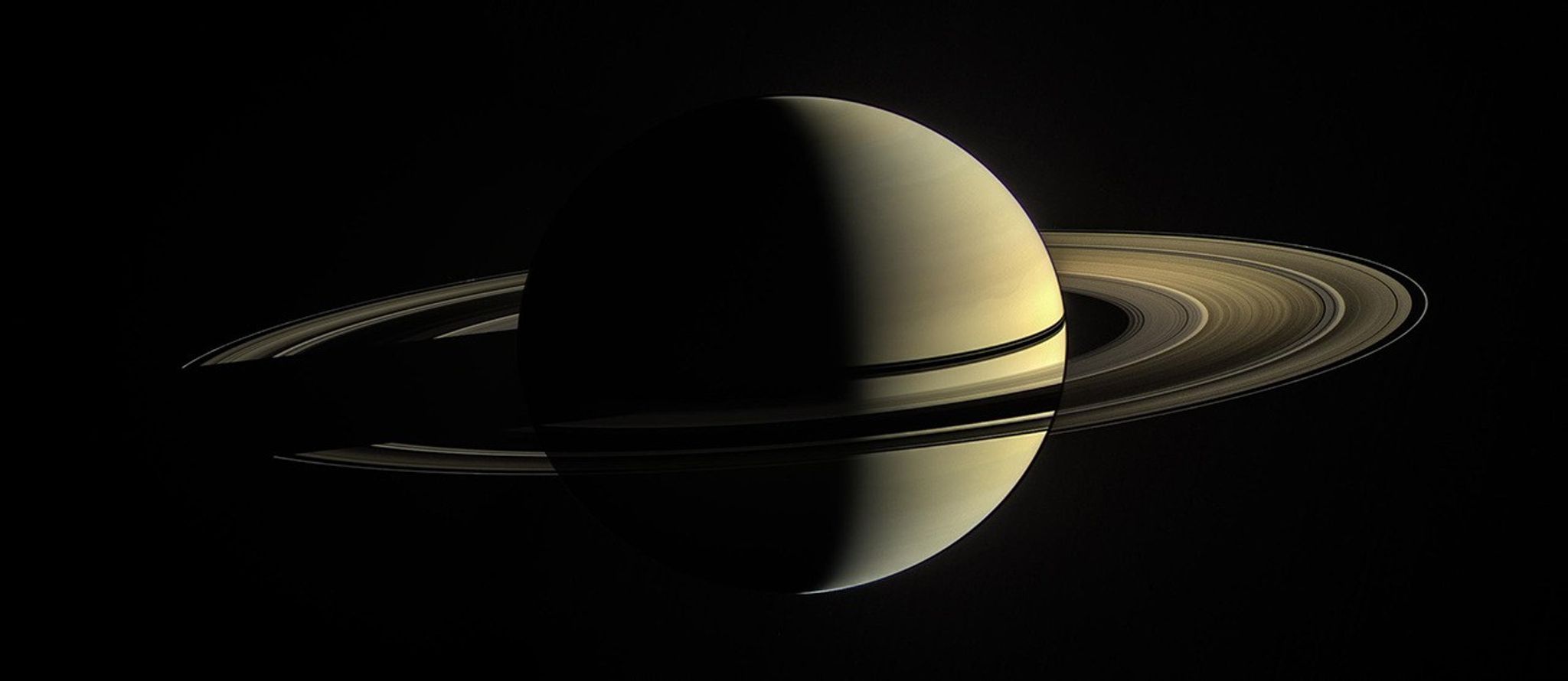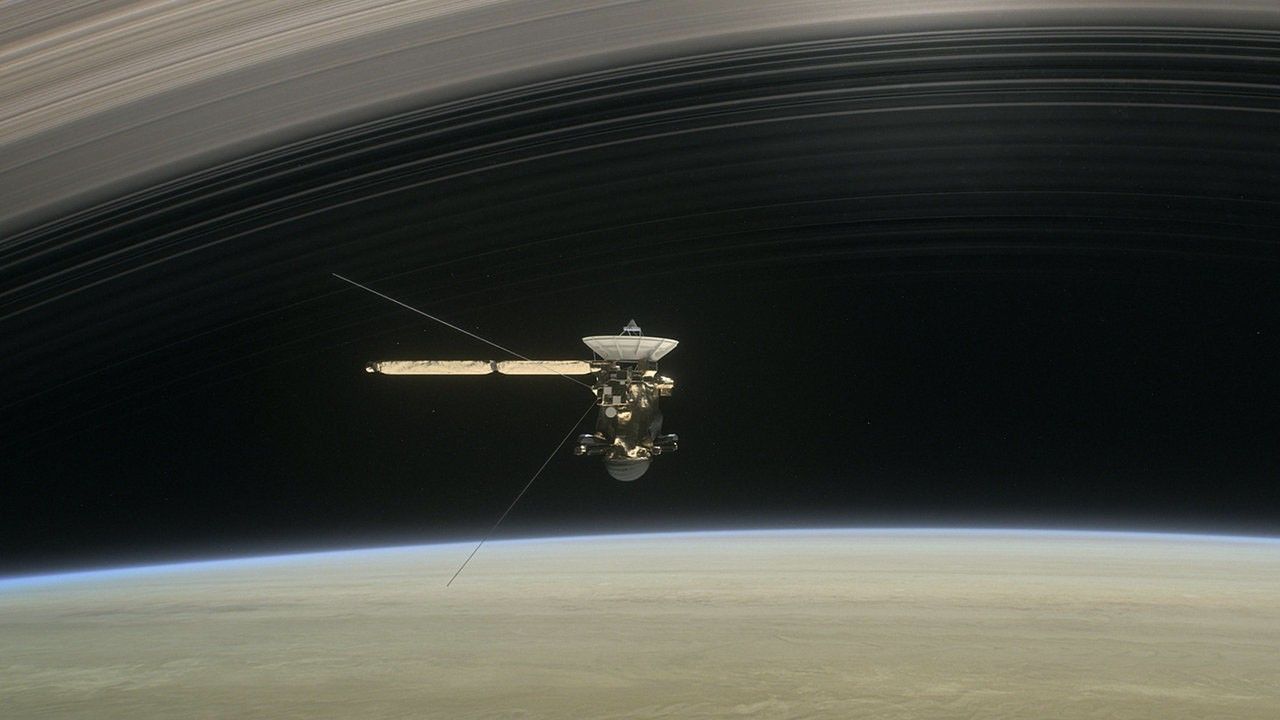Grand Finale Overview
After two decades in space, NASA's Cassini spacecraft ended its remarkable journey of exploration with a grand finale.
Having expended almost every bit of the rocket propellant it carried to Saturn, operators deliberately plunged Cassini into the planet to ensure Saturn's moons remain pristine for future exploration—in particular, the ice-covered, ocean-bearing moon Enceladus, but also Titan, with its intriguing pre-biotic chemistry.
Beginning in 2010, Cassini began a seven-year mission extension in which it completed many moon flybys while observing seasonal changes on Saturn and Titan. The plan for this phase of the mission was to expend all of the spacecraft's propellant while exploring Saturn, ending with a plunge into the planet's atmosphere.
In April 2017, Cassini was placed on an impact course that unfolded over five months of daring dives—a series of 22 orbits that each passed between the planet and its rings. Called the Grand Finale, this final phase of the mission brought unparalleled observations of the planet and its rings from closer than ever before.
On Sept. 15, 2017, the spacecraft made its final approach to the giant planet Saturn. But this encounter was like no other. This time, Cassini plunged into the planet's atmosphere, sending science data for as long as its small thrusters could keep the spacecraft's antenna pointed at Earth. Soon after, Cassini burned up and disintegrated like a meteor.
To its very end, Cassini was a mission of thrilling exploration. Launched on Oct. 15, 1997, the mission entered orbit around Saturn on June 30, 2004 (PDT), carrying the European Huygens probe. After its four-year prime mission, Cassini's tour was extended twice. Its key discoveries included the global ocean with indications of hydrothermal activity within Enceladus, and liquid methane seas on Titan.
And although the spacecraft may be gone, its enormous collection of data about Saturn—the giant planet itself, its magnetosphere, rings and moons—will continue to yield new discoveries for decades.
What Was The Grand Finale?
In April 2017, NASA's Cassini spacecraft began writing the final, thrilling chapter of its remarkable 20-year-long story of exploration: its Grand Finale.
Every week, Cassini dived through the approximately 1,200-mile-wide (2,000-kilometer-wide) gap between Saturn and its rings. No other spacecraft had ever explored this unique region.
A final close flyby of the moon Titan on April 22 used the moon's gravity to reshape Cassini's trajectory so that the spacecraft leapt over the planet's icy rings to pass between the rings and Saturn. During 22 such passes over about five months, the spacecraft's altitude above Saturn's clouds varied from about 1,000 to 2,500 miles (1,600 to 4,000 kilometers), thanks to occasional distant passes by Titan that shifted the closest approach distance. At times, Cassini skirted the very inner edge of the rings; at other times, it skimmed the outer edges of the atmosphere. During its final five orbits, its orbit passed through Saturn's uppermost atmosphere, before finally plunging directly into the planet on Sept. 15.
A Daring Dive
Cassini's Grand Finale was about so much more than the spacecraft's final dive into Saturn. That dramatic event was the capstone of six months of daring exploration and scientific discovery. And those six months were the thrilling final chapter in a historic 20-year journey.
At times, the spacecraft skirted the very inner edge of the rings; at other times, it skimmed the outer edges of the atmosphere. While the mission team was confident the risks were well understood, there could still have surprises. It was the kind of bold adventure that could only be undertaken at the end of the mission.
Unique Science
As Cassini plunged past Saturn, the spacecraft collected some incredibly rich and valuable information that was too risky to obtain earlier in the mission:
- The spacecraft made detailed maps of Saturn's gravity and magnetic fields, revealing how the planet is arranged internally, and possibly helping to solve the irksome mystery of just how fast Saturn is rotating.
- The final dives vastly improved our knowledge of how much material is in the rings, bringing us closer to understanding their origins.
- Cassini's particle detectors sampled icy ring particles being funneled into the atmosphere by Saturn's magnetic field.
- Its cameras took amazing, ultra-close images of Saturn's rings and clouds.
Discoveries to the End
Cassini’s final images were sent to Earth several hours before its final plunge, but even as the spacecraft made its fateful dive into the planet's atmosphere, it was sending home new data in real-time. Key measurements came from its mass spectrometer, which sampled Saturn's atmosphere, telling us about its composition until contact was lost.
While it's always sad when a mission comes to an end, Cassini's finale plunge was a truly spectacular end for one of the most scientifically rich voyages yet undertaken in our solar system. From its launch in 1997 to the unique Grand Finale science of 2017, the Cassini-Huygens mission racked up a remarkable list of achievements.
Why End the Mission?
By 2017, Cassini had spent 13 years in orbit around Saturn, following a seven-year journey from Earth. The spacecraft was low on the rocket fuel used for adjusting its course. If left unchecked, this situation would have eventually prevented mission operators from controlling the course of the spacecraft.
Two of Saturn's moons – Enceladus, and Titan – have captured news headlines as Cassini data revealed their potential to contain habitable – or at least "prebiotic” – environments.
In order to avoid the unlikely possibility of Cassini someday colliding with one of these moons, NASA chose to safely dispose of the spacecraft in the atmosphere of Saturn. This ensured that Cassini could not contaminate any future studies of habitability and potential life on those moons.
NASA’s Cassini spacecraft and ESA’s Huygens probe expanded our understanding of the kinds of worlds where life might exist and eight more reasons the mission changed the course of planetary exploration.
10 Things: Why Cassini Mattered
The Cassini spacecraft has been gone for a year now, but the science continues. Here are 10 reasons why Cassini…
Read the Story






























